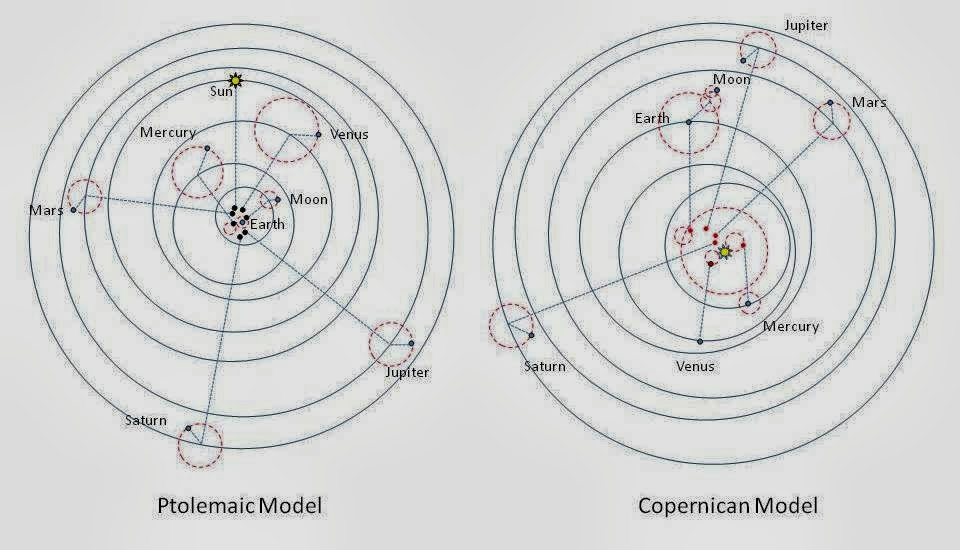THAT is a Great Diagram, Tzor. BUT since the orbit of planets is (as you correctly stated) elliptical, and not circular, then I find your spirograph and Fourier Series arguments moot, irrelevant, and incorrect.
The idea of circular orbits of planets come from (is credited to the astronomer Ptolemy, in Greek Alexandria, Egypt. (This is all based on memory and courses I took on the History of Science, so that specific fact may be SLIGHTLY incorrect, as is true of what I am posting here.) In order to keep true the idea of circular orbits of planets (including the sun and moon, BTW), it was necessary to create ideas such as retrograde motion (Planets that "seem" to move "backwards."
All of this was rendered overly complex in a geo-centric system of Ptolemy. If the SUN were the center of the solar system (a heliocentric one, as opposed to Ptolemy's geo-centric model, the motion of planets became more simple to explain. Kepler had a massive amount of astronomical observations and data, including much data from Tycho Brahe. Kepler then developed his 3 laws of planetary motion, which Newton used to help formulate the law of universal gravitation. (Johann Kepler was one of those "giants" he spoke of in his famous quote about sitting on the shoulders of giants.) I think it was Newton who discovered that the path of planets had to be an ellipse if it were to follow the data suggesting an inverse square law of motion. When asked by the proof by Wren and Halley (the one whom the comet is named for), Newton said he had it "somewhere" but was not sure where. That convinced Wren to have Newton publish his findings and theories, which became the famous book referred to as Principia. (You can look up the exact title involving Prinicipia Naturalis Philosophia Mathematica or some such Latin Phrase and title.) Either Wren (or possibly Halley) paid to have the book published in 1676 or so and basically revolutionized Physics, Science, and ASTRONOMY.
As far as Galileo, I do not understand what things he got wrong. He too wrote a famous book in science; one is (translated as the Starry Messenger (again, Latin Siderius.......[forgot the other word, sorry, the course was taken in 1978]) and a later book Dialogues on New World Systems. In Dialogues, Galileo discusses the "new" physics, explaining free fall and inertia and other basic Physics concepts, still VALID TODAY. IN the Starry Messenger, Galileo announced his discoveries having used his telescope. These include the 4 moon (he named them after his financial sponsor, the Medicis, now know as Galilean moons: Io, Ganymede, Callista or Callisto, and Europa). This also includes the rings around Saturn and sunspots. The discovery of the moons of Jupiter was the most damaging to the Ptolemy's universe. There was no prediction of a planet having moons. The earth was NOT a planet back the;, it was "special" and the center of the entire universe. So what Galileo GOT WRONG I do not get; he may have gotten a few details wrong, BUT he did significantly modify the BIG PICTURE and GOT it very correct. Galileo confirmed the heliocentric Copernican universe (in the book On the Revolution of Heavenly Bodies by Copernicus) was much closer to the truth than Ptolemy’s universe and system. This book made the word revolutionary very REVOLUTIONARY, indeed.
Speaking of Telescopes, the subject that got this thread going, I got to see the rings of Saturn and the 4 Galilean moons through two different telescopes when the Richmond (VA) Astronomical Society set up three of them about 10 years ago for a public viewing. TO see with my own eyes using a good size telescope (magnification was maybe 50x or so; I cannot recall the exact #) those things described by Galileo in his book The Starry Messenger WAS AWESOME. BTW: the third telescope allowed the use to "lock into" a celestial object by correcting for the earth's rotation. Ten years ago (or so), when smart phones were getting started, this was FANTASTIC. With it, the owner locked into a distant nebula, which was "fuzzy" and does not have historical significance, at least not to me.
So telescopes (used for astronomy) is like any hobby: if one really gets "into" it, one can spend LOTS of money to get better stuff and possibly enjoy the fun and experience that much more. Also many recent comet discoveries were done by amateur astronomers, such as Levy and Shoemaker(s). (As I recall, the Shoemaker-Levi comet is the one that crashed into Jupiter some 25 years ago.)
tzor wrote:DoomYoshi wrote:You may appreciate this article:
First and foremost, all of the theories were flat out wrong, not because of what went where and what "moved" and what did not, but because of a more simple fact ... orbits are elliptical not circular.
A long time ago there was a toy called a Spirograph. Simply out you have a gear within a gear within a gear and you have a pen and it makes all kinds of fun things.
- Click image to enlarge.

Well it turns out this is a basic example of a Fourier Transformation. You can make any orbit as a series of such circles.
Both models had to use these circles and they used a lot of them. In other words, both models were confusing has hell.
Galileo may have been the Al Gore of his day. He had no idea what he was talking about, all of his predictions were flat out wrong but he might have been generally correct in the end.


